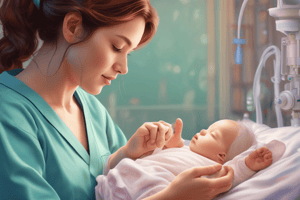Podcast
Questions and Answers
What is the primary function of the rooting reflex in newborns?
What is the primary function of the rooting reflex in newborns?
- To enhance self-protection
- To aid in motor development
- To facilitate feeding (correct)
- To promote balance and coordination
Which reflex is responsible for the extension of the arm on one side and flexion of the arm on the other side?
Which reflex is responsible for the extension of the arm on one side and flexion of the arm on the other side?
- Grasp Reflex
- Moro Reflex
- Babinski Reflex
- Tonic Neck Reflex (correct)
What happens when the sole of a newborn's foot is stroked?
What happens when the sole of a newborn's foot is stroked?
- Their toes will fan out and their big toe will move upwards (correct)
- Their foot will remain still
- Their big toe will move downwards
- Their toes will curl inward
At what age do newborn reflexes typically disappear?
At what age do newborn reflexes typically disappear?
What is the purpose of the sucking reflex?
What is the purpose of the sucking reflex?
Which reflex helps with self-protection in newborns?
Which reflex helps with self-protection in newborns?
What happens when a newborn's cheek or lips are stroked?
What happens when a newborn's cheek or lips are stroked?
What is the primary function of the grasp reflex in newborns?
What is the primary function of the grasp reflex in newborns?
Why are newborn reflexes essential for infants?
Why are newborn reflexes essential for infants?
Flashcards are hidden until you start studying
Study Notes
Newborn Reflexes
Newborn reflexes are automatic reactions to specific stimuli that are present in infants from birth to around 4-6 months of age. These reflexes are essential for the baby's survival and development.
Types of Newborn Reflexes
- Rooting Reflex: When the baby's cheek or lips are stroked, they will turn their head towards the stimulus and open their mouth. This reflex helps with feeding.
- Sucking Reflex: When the baby's mouth or lips are stimulated, they will begin to suck. This reflex helps with feeding and nutrition.
- Tonic Neck Reflex: When the baby's head is turned to one side, the arm on that side will extend, and the arm on the other side will flex. This reflex helps with movement and balance.
- Moro Reflex: When the baby feels like they are falling, they will extend their arms and legs and may even cry. This reflex helps with balance and self-protection.
- Grasp Reflex: When the baby's palm is stroked, they will grasp the stimulus. This reflex helps with motor development and hand-eye coordination.
- Babinski Reflex: When the sole of the baby's foot is stroked, their toes will fan out and their big toe will move upwards. This reflex helps with motor development and balance.
Importance of Newborn Reflexes
- Help the baby adapt to their new environment
- Aid in feeding and nutrition
- Assist with motor development and coordination
- Provide a sense of security and comfort
- Are a normal part of development and usually disappear on their own as the baby grows and develops
Studying That Suits You
Use AI to generate personalized quizzes and flashcards to suit your learning preferences.



